wheel DATSUN 210 1979 Workshop Manual
[x] Cancel search | Manufacturer: DATSUN, Model Year: 1979, Model line: 210, Model: DATSUN 210 1979Pages: 548, PDF Size: 28.66 MB
Page 352 of 548
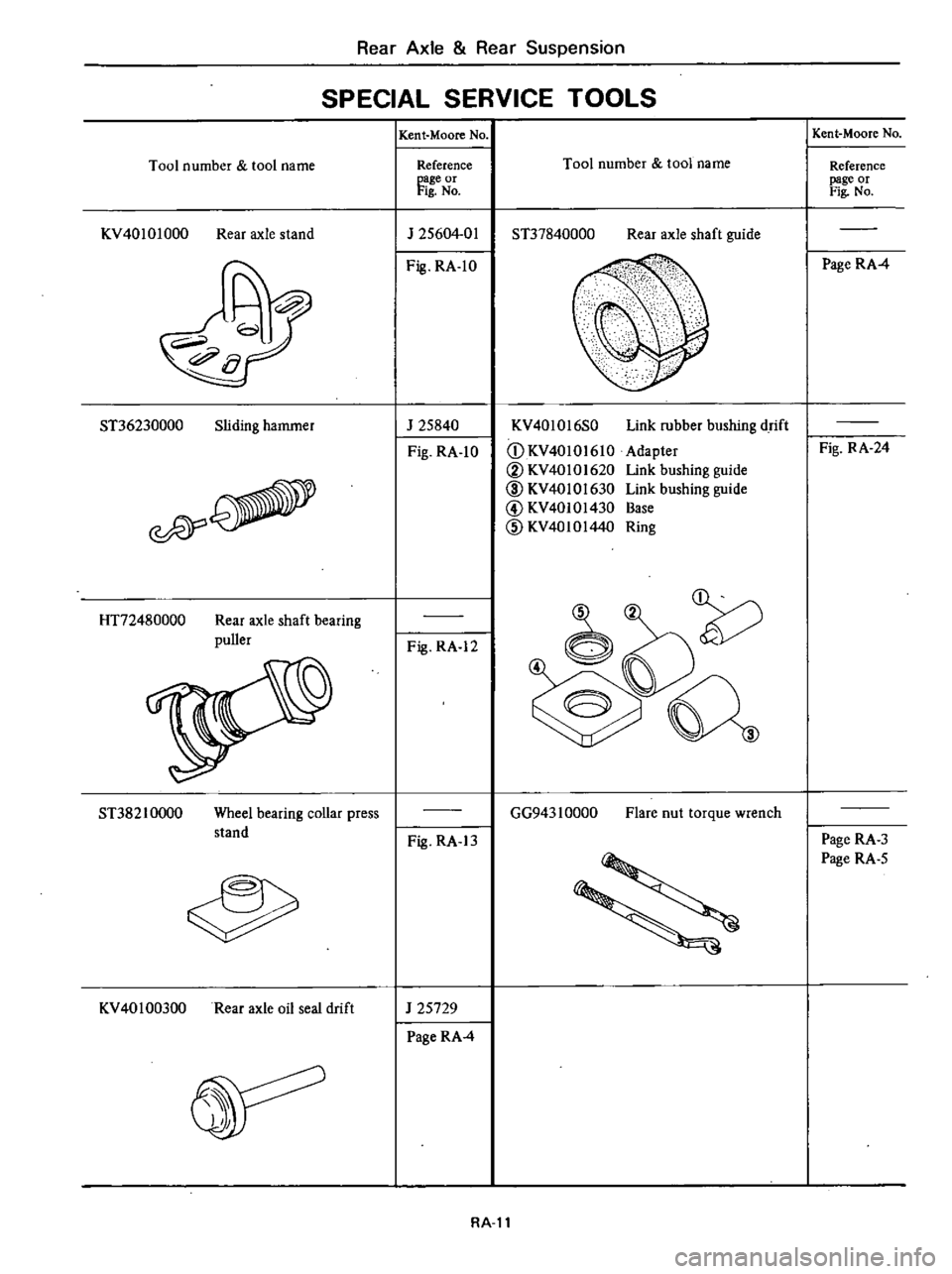
Rear
Axle
Rear
Suspension
SPECIAL
SERVICE
TOOLS
Tool
number
tool
name
KV40101000
Rear
axle
stand
ST36230000
Sliding
hammer
esPY
HT72480000
Rear
axle
shaft
bearing
puller
ST38210000
Wheel
bearing
collar
press
stand
KV
401
00300
Rear
axle
oil
seal
drift
Kent
Moore
No
Reference
page
or
Fig
No
J
25604
01
Fig
RA
1O
J
25840
Fig
RA
1O
Fig
RA
12
Fig
RA
13
J
25729
Page
RA
4
Tool
number
tool
name
ST37840000
Rear
axle
shaft
guide
KV40l016S0
CD
KV40
10
I
610
V
KV40101620
ID
KV4010l630
@
KV40101430
CID
KV4010144
Link
rubber
bushing
drift
Adapter
Link
bushing
guide
Link
bushing
guide
Base
Ring
GG943
1
0000
Flare
nut
torque
wrench
RA
ll
Kent
Moore
No
Reference
page
or
Fig
No
Page
RA
4
Fig
RA
24
Page
RA
3
Page
RA
5
Page 355 of 548
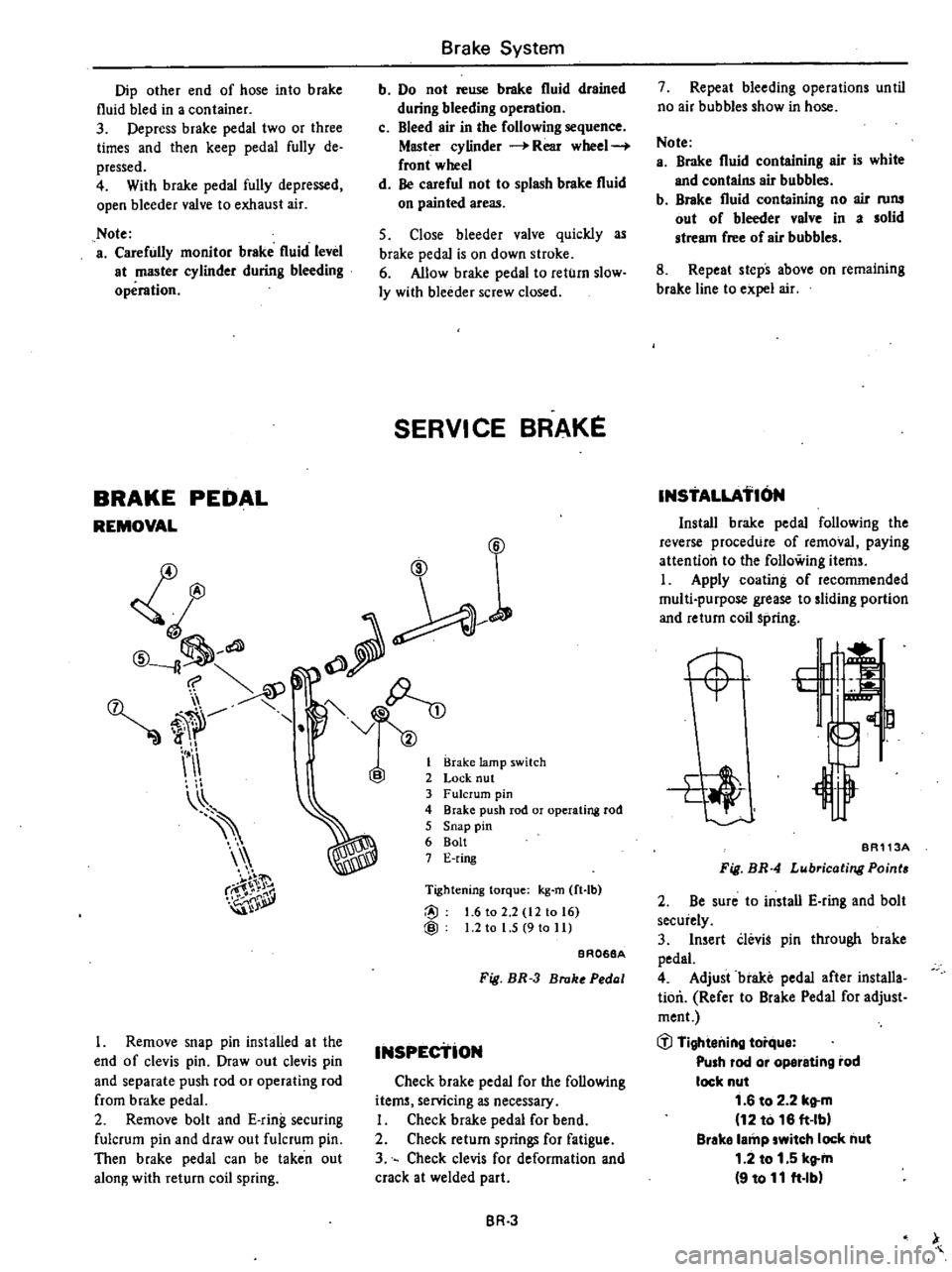
L
@
fl
JJ
l
f
m
ff
v
1
II
2
I
I
II
B
s1
r
Dip
other
end
of
hose
into
brake
fluid
bled
in
a
container
3
Pepress
brake
pedal
two
or
three
times
and
then
keep
pedal
fully
de
pressed
4
With
brake
pedal
fully
depressed
open
bleeder
valve
to
exhaust
air
Note
a
Carefully
monitor
brake
fluid
level
at
master
cylinder
during
bleeding
operation
BRAKE
PEDAL
REMOVAL
I
Remove
snap
pin
installed
at
the
end
of
clevis
pin
Draw
out
clevis
pin
and
separate
push
rod
or
operating
rod
from
brake
pedal
2
Remove
bolt
and
E
ring
securing
fulcrum
pin
and
draw
out
fulcrum
pin
Then
brake
pedal
can
be
taken
out
along
with
return
coil
spring
Brake
System
b
Do
not
reuse
brake
fluid
drained
during
bleeding
operation
c
Bleed
air
in
the
following
sequence
Master
cylinder
Rear
wheel
front
wheel
d
Be
careful
not
to
splash
brake
fluid
on
painted
areas
5
Close
bleeder
valve
quickly
as
brake
pedal
is
on
down
stroke
6
Allow
brake
pedal
to
return
slow
ly
with
bleeder
screw
closed
SERVI
CE
BRAKE
fJ
Brake
lamp
switch
Lock
nut
Fulcrum
pin
Brake
push
rod
or
operating
rod
Snap
pin
Bolt
E
ring
Tightening
torque
kg
m
ft
Ib
@
1
6
to
2
2
12
10
16
@
1
2
to
l
S
9
to
II
BROS8A
Fig
BR
3
Broke
Pedal
INSPEctioN
Check
brake
pedal
for
the
following
items
servicing
as
necessary
I
Check
brake
pedal
for
bend
2
Check
return
springs
for
fatigue
3
Check
clevis
for
deformation
and
crack
at
welded
part
BR
3
7
Repeat
bleeding
operations
until
no
air
bubbles
show
in
hose
Note
a
Brake
fluid
containing
air
is
white
and
contalns
air
bubbles
b
Brake
fluid
containing
no
air
rons
out
of
bleeder
valve
in
a
solid
stream
free
of
air
bubbles
8
Repeat
steps
above
on
remaining
brake
line
to
expel
air
INSTALLATION
Install
brake
pedal
following
the
reverse
procedure
of
removal
paying
attention
to
the
following
items
I
Apply
coating
of
recommended
multi
purpose
grease
to
sliding
portion
and
return
coil
spring
BA113A
Fit
BR
4
Lubricating
Point
2
Be
sure
to
install
E
ring
and
bolt
securely
3
Insert
CleviS
pin
through
brake
pedal
4
Adjust
brake
pedal
after
installa
tion
Refer
to
Blake
Pedal
for
adjust
ment
j
Tightening
torque
Push
rod
or
op8leting
rod
lock
nut
1
6
to
2
2
kltm
12
to
16
ft
Ibl
Brake
lamp
switch
lock
nut
1
2
to
1
5
kltin
9
to
11
ft
lb
Page 358 of 548
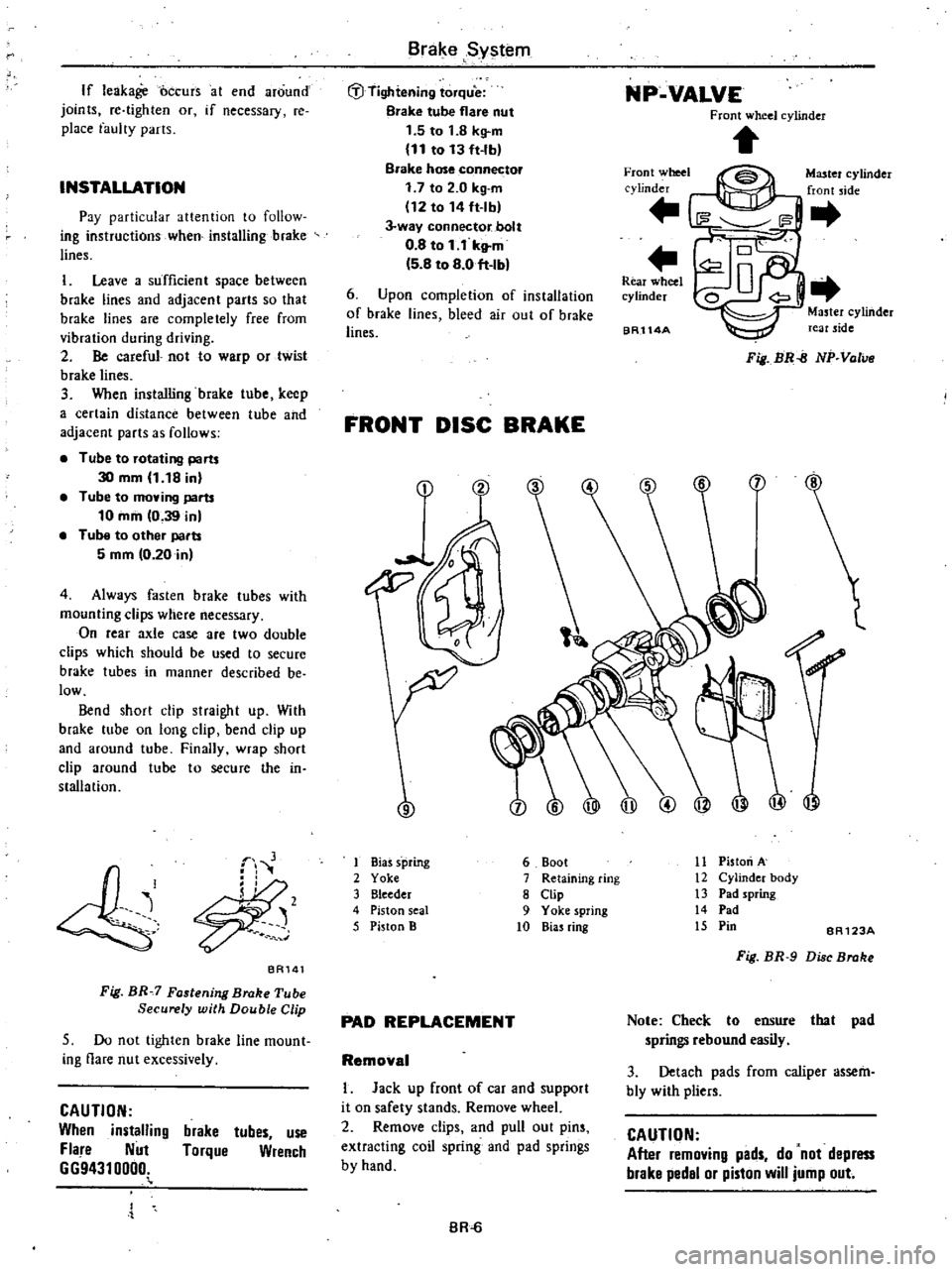
If
leakage
oCcurs
at
end
around
joints
re
tighten
Of
if
necessary
re
place
faulty
parts
INSTALLATION
Pay
particular
attention
to
follow
ing
instructions
when
installing
brake
lines
I
Leave
a
sulfident
space
between
brake
lines
and
adjacent
parts
so
that
brake
lines
are
completely
free
from
vibration
during
driving
2
Be
careful
not
to
warp
or
twist
brake
lines
3
When
installing
brake
tube
keep
a
certain
distance
between
tube
and
adjacent
parts
as
follows
Tube
to
rotating
parts
30
mm
1
18
in
Tube
to
moving
parts
10
mm
10
39
in
Tube
to
other
palls
5
mm
10
20
in
4
Always
fasten
brake
tubes
with
mounting
clips
where
necessary
On
rear
axle
case
are
two
double
dips
which
should
be
used
to
secure
brake
tubes
in
manner
described
be
low
Bend
short
clip
straight
up
With
brake
tube
on
long
clip
bend
clip
up
and
around
tube
Finally
wrap
short
clip
around
tube
to
secure
the
in
slallation
f
J
i
2
BA141
Fig
BR
7
Fastening
Brake
Tube
Securely
with
Double
Clip
5
Do
not
tighten
brake
line
mount
ing
flare
nut
excessively
CAUTION
When
installing
Fla
e
Nut
6694310000
brake
tubes
use
Torque
Wrench
Brake
System
t
D
Tightening
torque
Brake
tube
flare
nut
1
5
to
1
8
kg
m
11
to
13
ft
lb
Brake
hose
connector
1
7
to
2
0
kg
m
112
to
14
ft
lb
J
way
connector
bolt
0
8
to
1
1
kltm
5
8
to
8
0
ft
Ib
NP
VALVE
Front
wheel
cylinder
Front
wheel
cylinder
Master
cylinder
front
jde
6
Upon
completion
of
installation
of
brake
lines
bleed
air
out
of
brake
lines
Rear
wheel
cylinder
BR114A
Master
cylinder
rear
side
Fig
BR
B
NP
Valve
FRONT
DISC
BRAKE
9
ilJ
I
Bias
s
pring
2
Yoke
3
Bleeder
4
Piston
seal
5
Piston
B
11
Piston
A
12
Cylinder
body
13
Pad
spring
14
Pad
15
Pin
6
Boot
7
Retaining
ring
8
Clip
9
Yoke
spring
10
Bias
ring
BR123A
Fig
BR
9
Di
c
Broke
PAD
REPLACEMENT
Note
Check
to
ensure
that
pad
springs
rebound
easily
3
Detach
pads
from
caliper
assem
bly
with
pliers
Removal
I
Jack
up
front
of
car
and
support
it
on
safety
stands
Remove
wheel
2
Remove
clips
and
pull
out
pins
extracting
coil
spring
and
pad
springs
by
hand
CAUTION
After
removing
pads
do
not
depress
brake
pedal
or
piston
will
jump
out
BR
Page 359 of 548
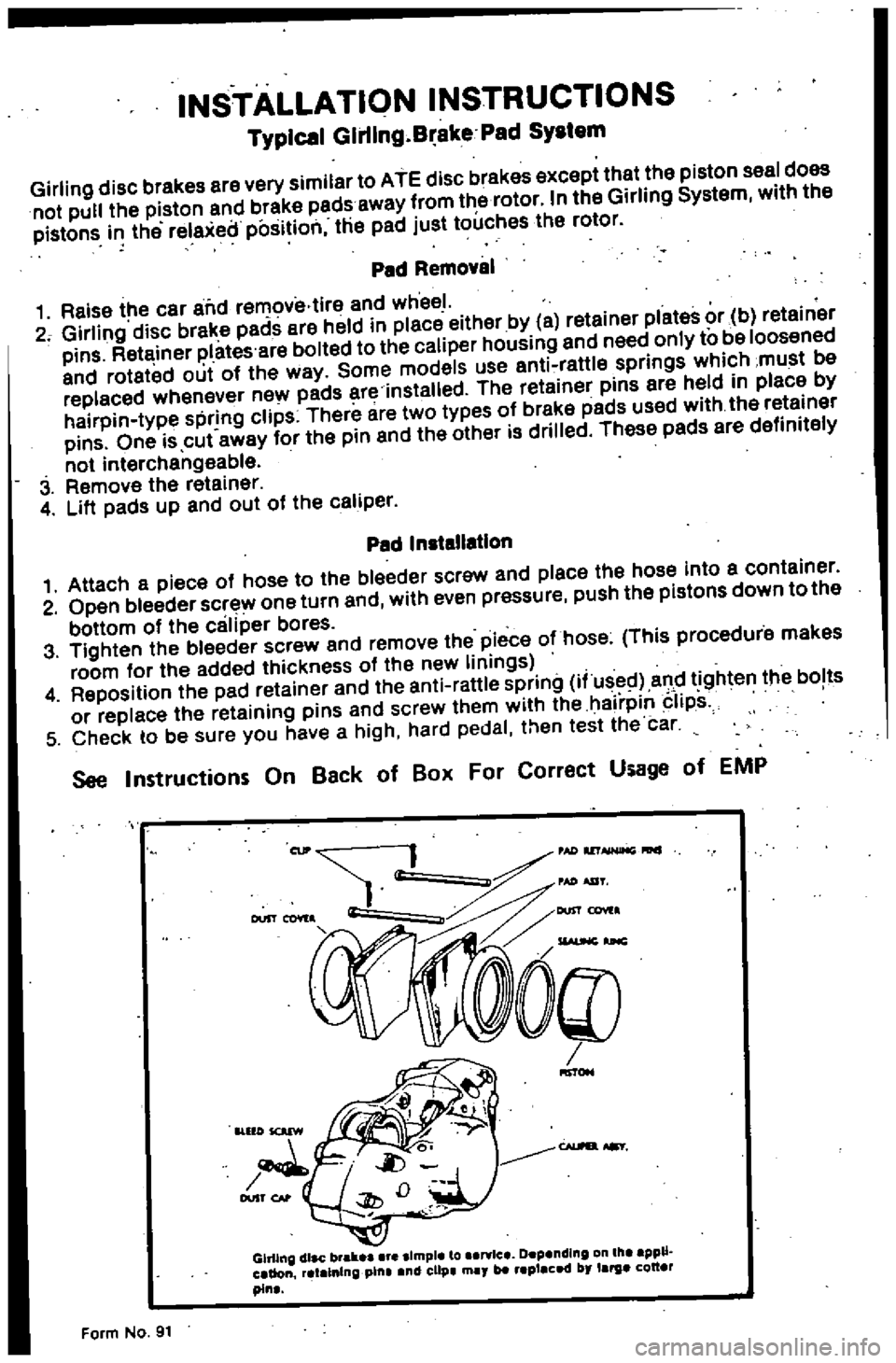
INSTALLATION
INSTRUCTIONS
Typical
Glrllng
B
ake
Pad
SYIlem
Girling
disc
brakes
are
very
similar
to
ATE
disc
brakes
except
that
the
piston
seal
does
not
pul
the
piston
and
brake
pads
away
from
the
rotor
In
the
Girling
System
with
the
pistons
i
the
relaxeilposition
the
pad
just
touches
the
rotor
Ped
Removal
1
Raise
the
car
alid
removiHire
and
wheel
2
Girling
disc
brake
pads
ere
held
in
piece
either
by
a
retainer
plates
or
b
retainer
pins
Retainer
plates
are
boiled
to
the
caliper
housing
and
need
only
to
be
loosened
and
roteted
out
of
the
way
Some
models
use
anti
raWe
springs
which
must
be
replaced
whenever
new
pads
ere
installed
The
retainer
pins
are
held
in
place
by
hairpin
type
spring
clips
There
are
two
types
of
breke
pads
used
with
the
retainer
pins
One
is
cut
away
for
the
pin
end
the
other
is
drilled
These
padS
ere
definitely
not
interchengeable
3
Remove
the
reteiner
4
Lift
padS
up
and
out
of
the
celiper
Pad
Installation
1
Attach
a
piece
of
hose
to
the
bleeder
screw
and
place
the
hose
into
a
container
2
Open
bleeder
screw
one
turn
and
with
even
pressure
push
the
pistons
down
to
the
bottom
of
the
caliper
bores
3
Tighten
the
bleeder
screw
and
remove
the
piece
o
hose
This
procedure
makes
room
for
the
added
thickness
of
the
new
linings
4
Reposition
the
pad
retainer
and
the
anti
rattle
spring
i
used
and
tighten
the
bolts
or
replace
the
retaining
pins
and
screw
them
with
the
hairpin
Iips
5
Check
to
be
sure
you
have
a
high
hard
pedal
then
test
the
car
See
Instructions
On
Back
of
Ball
For
Correct
Usage
of
EMP
Gh11ng
dlac
brall
Ilmple
to
art
lc
Depending
III
ppU
aUon
atalnln
pilla
nd
clip
may
blt
placed
by
larga
QU
pin
Form
No
91
Page 360 of 548
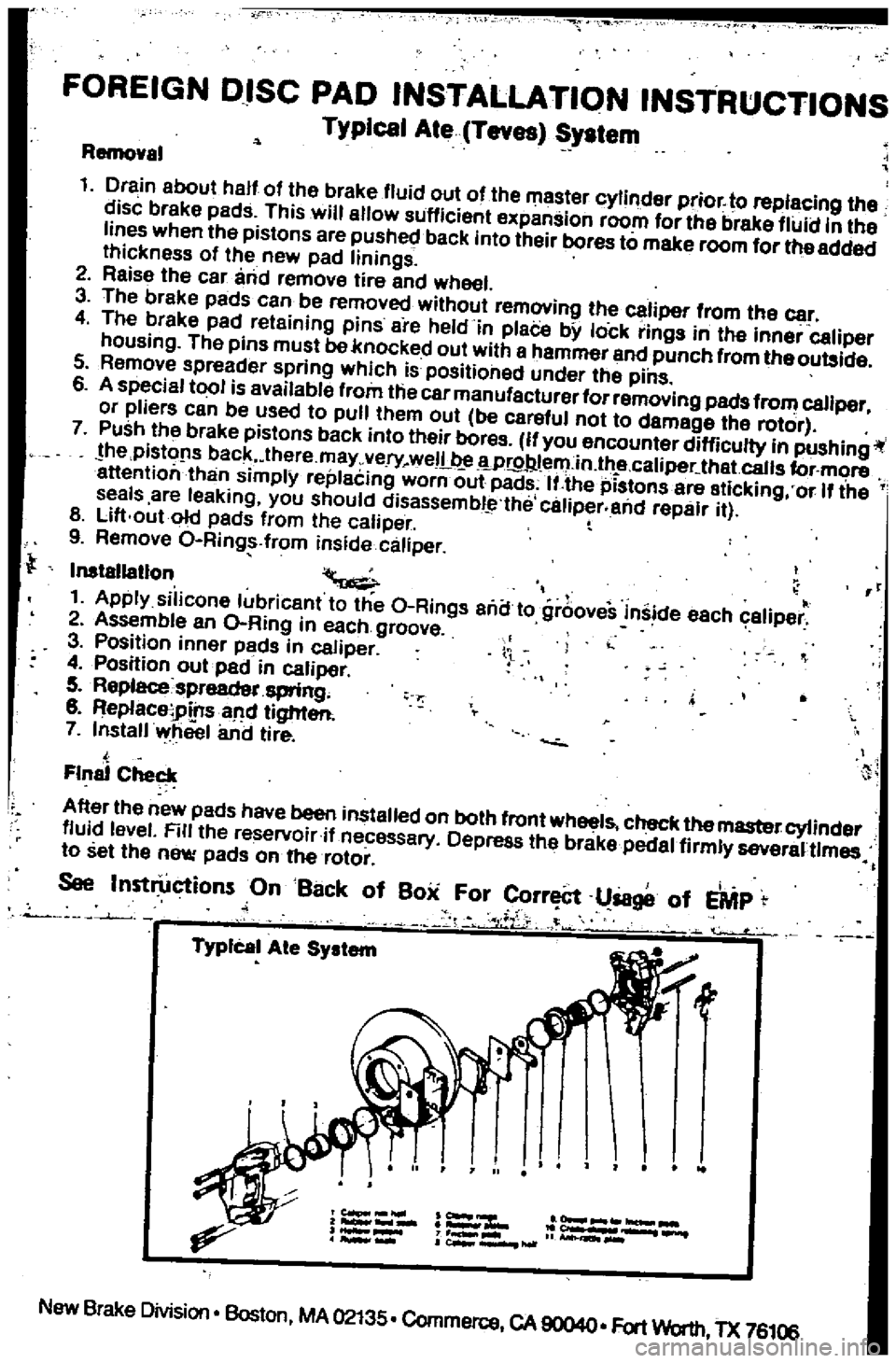
FOREIGN
DISC
PAD
INSTALLATION
INSTRUCTIONS
Typical
Ate
Teves
System
Removel
1
Drain
about
half
of
the
brake
fluid
out
of
the
master
cylinder
prior
to
replacing
the
disc
brake
pads
This
will
allow
sufficient
expansion
room
for
the
brake
fluid
in
the
lines
when
the
pistons
are
pushed
back
into
their
bores
to
make
room
for
the
added
Ihickness
of
the
new
pad
linings
2
Reise
the
car
and
lemove
tire
and
wheel
3
The
breke
pads
can
be
removed
without
lemovinll
the
caliper
from
the
car
4
The
brake
pad
reteining
pins
are
held
in
plaCe
bY
lock
rinlls
in
Ihe
inner
caliper
housing
The
pins
must
be
knocked
out
with
e
hammel
end
punch
from
theoulllide
5
Remove
spreader
spring
which
is
positioned
under
the
pins
6
A
special
tool
is
available
flom
the
car
manufacturer
forremoving
pads
from
caliper
or
pliers
can
be
used
to
pull
them
oul
be
careful
not
to
damage
the
rotor
7
Push
Ihe
brake
pistons
back
into
their
boros
If
you
encounter
difficulty
in
pushingil
he
pistofls
back
lhere
may
very
weIL
Wr9Jl
l
ern
in
lh
e
caliper
that
calls
for
more
attention
than
simplY
replecing
worn
out
pads
IUhe
pistons
are
eticking
or
If
the
seals
are
leaking
you
should
disassembl
the
caliper
and
repair
il
8
Lift
out
old
pads
from
Ihe
caliper
9
Remove
O
Ring
from
inside
caliper
Inslallatlon
II
1
Apply
silicone
lubricanl
to
Ihe
O
Rings
ana
to
grooveS
inside
each
caliper
2
Assemble
an
O
Ring
in
each
groove
3
Position
innor
pads
in
caliper
4
Position
oulpad
in
caliper
5
Replacespreadet
spring
8
ReplaceiPtnsaM
lighter
7
Install
wheel
and
lire
l
Final
Checl
A
Iter
Ihe
new
padS
have
been
installed
on
bolh
front
wheel
check
the
master
cylinder
fluid
level
Rlllhe
reservoiril
necessary
Depress
Ihe
brake
pedal
firmly
severaUlmes
to
sellhe
new
pads
on
he
rotor
i
See
Inst
ctionsOnBat
k
of
Box
For
rr
l8ge
of
EMP
l
iL
1
f
J
TypIcal
Ale
System
New
Brake
Division
Boston
MA
02135
Commerce
CA
90040
Fort
Worth
TX
76106
Page 361 of 548

BR563
Fig
BR
10
Removing
Pad
Inspection
Clean
pads
with
cleaning
solvent
CAUTION
Use
brake
fluid
to
clean
Never
use
mineral
oil
2
When
pads
are
heavily
fouled
with
oil
or
grease
or
when
pad
is
deteriorated
or
deformed
replace
it
3
If
pad
is
worn
to
less
than
the
specified
value
replace
Pad
wear
limit
Minimum
thickness
t
6
mm
0
063
in
Note
Always
replace
pads
in
pad
kit
four
pads
two
clips
four
pad
pins
and
four
pad
springs
4
Check
rotor
referring
to
Rotor
for
inspection
Installetlon
I
Clean
and
apply
P
RC
grease
on
yoke
guide
groove
of
cylinder
body
sliding
contact
portions
of
yoke
and
end
surface
of
piston
Note
a
Do
not
use
common
brake
grease
b
Be
careful
not
to
get
brake
grease
on
rotor
and
pads
2
Loosen
air
bleeder
and
push
pis
ton
B
outer
piston
in
cylinder
until
end
surface
of
piston
B
coincides
with
end
surface
of
retaining
ring
on
boot
Then
inner
pad
can
be
installed
Brake
System
BR564
Fig
BR
11
Pushing
Piston
CAUTION
Piston
can
be
easily
pushed
in
by
hand
but
if
pushed
too
far
groove
of
piston
will
go
inside
of
piston
seal
as
shown
in
Fig
BR
12
At
this
point
if
piston
is
pressured
or
moved
piston
seal
will
be
damaged
If
piston
has
been
pushed
in
too
far
remove
brake
assembly
and
disassemble
it
Then
push
piston
out
in
the
direction
shown
by
arrow
Assemble
it
again
referring
to
follow
ing
section
00
I
Normal
I
position
L
BR409
Fig
BR
12
Position
for
Pushing
Piston
3
Push
piston
A
inner
piston
in
cylinder
by
pulling
yoke
as
shown
The
outer
pad
can
then
be
installed
BRS6S
Fig
BR
13
Pulling
in
Piston
A
BR
7
4
After
installing
pads
depress
brake
pedal
several
times
and
pads
will
settle
into
proper
position
Note
When
worn
out
pads
are
re
placed
with
new
ones
brake
fluid
may
overflow
reservoir
While
re
placing
pads
keep
loosening
bleeder
to
release
brake
fluid
5
Install
wheels
and
lower
car
to
ground
REMOVAL
I
Remove
pads
Refer
to
Pad
Re
placement
2
Remove
brake
tube
from
caliper
assembly
CAUTION
When
removing
brake
tube
use
suit
able
tube
wrench
Never
use
open
end
or
adjustable
wrench
Note
Plug
up
hole
in
caliper
so
that
brake
fluid
does
not
flow
out
from
cylinder
body
3
Loosen
bolts
securing
cylinder
body
to
knuckle
spindle
and
remove
caliper
assembly
from
strut
DISASSEMBLY
I
Drain
brake
fluid
from
top
hole
of
cylinder
body
2
Push
both
pistons
A
and
B
into
cylinder
Refer
to
Pad
Replacement
3
Tap
cylinder
body
lightly
with
a
plastic
hammer
Cylinder
will
then
separate
from
yoke
BR115A
Fig
BR
14
Tapping
Cylinder
Block
Page 363 of 548

6
Apply
P
B
C
grease
to
yoke
slid
ing
part
of
cylinder
Then
reposition
bias
ring
so
that
groove
of
bias
ring
coincides
with
yoke
7
Leaving
yoke
springs
inserted
lightly
into
cylinder
groove
assemble
cylinder
body
and
yoke
by
pushing
or
tapping
yoke
lightly
BA570
Fig
BR
19
A
embling
Yoke
and
Cylinder
8
Install
air
bleeder
valve
on
caliper
INSTAlLATION
1
Install
in
reverse
procedure
of
removal
CAUTION
When
installing
brake
tube
use
Flare
Nut
Torque
Wrench
6694310000
fJ
Tightening
tOlque
Calipel
securing
bolts
4
6
to
6
1
kll
m
33
to
44
ft
lb
Brake
tube
flere
nuts
1
5to
1
8
kg
m
11
to
13
ft
Ib
2
After
installing
pad
bleed
air
from
system
Brake
System
ROTOR
REMOVAL
Refer
to
Front
Axle
Section
FA
for
removal
Note
As
this
value
increases
wear
occurs
progressively
vibration
cor
responding
to
revolution
of
tire
may
often
be
tmnsmitted
to
in
terior
of
car
INSPECTION
Check
the
following
items
and
if
necessary
replace
Checks
can
be
made
by
removing
only
wheel
Sliding
surface
If
there
are
cracks
or
considerable
chips
replace
2
Runout
Adjust
wheel
bearing
correctly
Using
a
dial
gauge
measure
runout
at
the
center
of
rotor
pad
contact
sur
face
Runout
limit
less
than
0
12
mm
0
0047
in
Total
indicator
reading
BR025A
Fig
BR
20
Mecuuring
Runout
3
Parallelism
Measure
thickness
of
entire
periph
cry
of
rotor
using
a
micrometer
Parallelism
when
new
less
than
0
03
mm
0
0012
in
BR
9
Fig
BR
21
Measuring
Parallelism
4
Thickness
If
rotor
thickness
is
beyond
wear
limit
replace
rotor
When
correcting
thickness
be
sure
that
the
thickness
after
correction
does
not
exceed
the
limit
Standard
thickness
10
0
mm
0
394
in
Wear
limit
more
than
8
4
mm
0
331
in
INSTALLATION
Install
rotor
in
reverse
order
of
removal
Adjust
wheel
bearing
preload
correctly
Refer
to
Front
Axle
Sec
tion
FA
for
adjustment
ifl
Tightening
torque
Rotor
to
wheel
hub
3
9
to
5
3
kg
m
28
to
38
ft
rb
Page 364 of 548
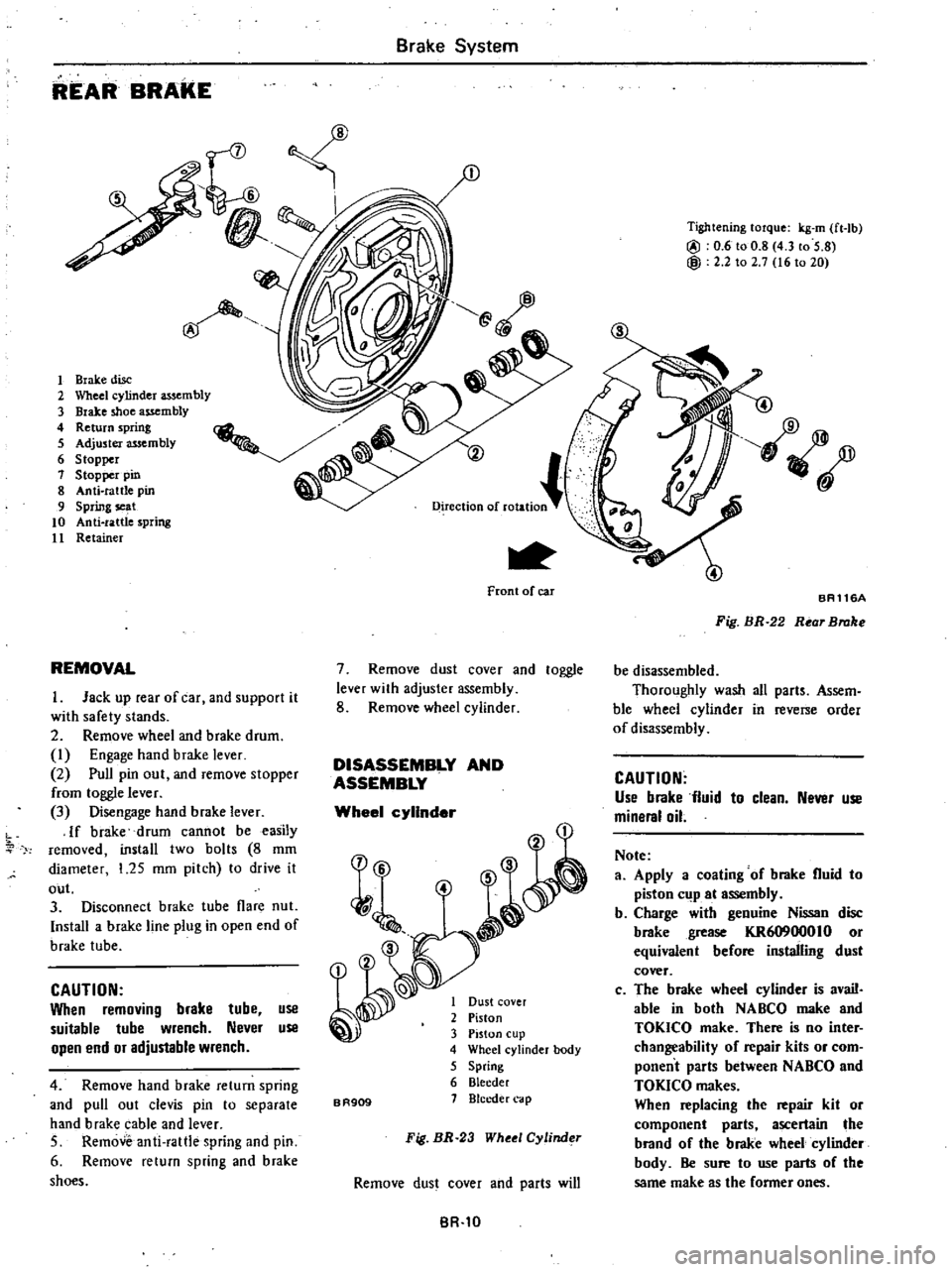
REAR
BRAKE
1
Brake
disc
2
Wheel
cylinder
assembly
3
Brake
shoe
assembly
4
Return
spring
5
Adjuster
assembly
6
Stopper
1
Stopper
pin
8
Anti
rattle
pin
9
Spring
se
t
10
Anti
rattle
spring
11
Retainer
REMOVAL
L
Jack
up
rear
of
car
and
support
it
with
safety
stands
2
Remove
wheel
and
brake
drum
I
Engage
hand
brake
lever
2
Pull
pin
out
and
remove
stopper
from
toggle
lever
3
Disengage
hand
brake
lever
If
brake
drum
cannot
be
easily
removed
install
two
baIts
8
mm
diameter
I
25
mm
pitch
to
drive
it
out
3
Disconnect
brake
tube
flare
nut
Install
a
brake
line
plug
in
open
end
of
brake
tube
CAUTION
When
removing
brake
tube
use
suitable
tube
wrench
Never
use
open
end
or
adjustable
wrench
4
Remove
hand
brake
return
spring
and
pull
out
clevis
pin
to
separate
hand
brake
cable
and
lever
5
Remove
anti
rattle
spring
and
pin
6
Remove
return
spring
and
brake
shoes
Brake
System
Dueetio
of
ro
tiO
Front
of
car
7
Remove
dust
cover
and
toggle
lever
with
adjuster
assembly
8
Remove
wheel
cylinder
DISASSEMBLY
AND
ASSEMBLY
Wheel
cylinder
BR909
I
Dust
cover
2
Piston
3
Piston
cup
4
Wheel
cylinder
body
5
Spring
6
Bleeder
1
Bleeder
cap
Fig
BR
23
Wheel
Cylinder
Remove
dust
cover
and
parts
will
BR
l0
Tightening
torque
kg
m
ft
lb
@
0
6
to
0
8
4
3
ro
5
8
@
2
2
to
2
7
16
to
20
BR116A
Fig
BR
22
Rear
Broke
be
disassembled
Thoroughly
wash
all
parts
Assem
ble
wheel
cylinder
in
reverse
order
of
disassembly
CAUTION
Use
brake
fluid
to
clean
Never
use
mineral
oil
Note
a
Apply
a
coating
of
brake
fluid
to
piston
cliP
at
assembly
b
Charge
with
genuine
Nissan
disc
brake
grease
KR60900010
or
equivalent
before
installing
dust
cover
c
The
brake
wheel
cylinder
is
avail
able
in
both
NABCO
make
and
TOKlCO
make
There
is
no
inter
changeability
of
repair
kits
or
com
ponent
parts
between
NABCO
and
TOKlCO
makes
When
replacing
the
repair
kit
or
component
parts
ascertain
the
brand
of
the
brake
wheel
cylinder
body
Be
sure
to
use
parts
of
the
same
make
as
the
fonner
ones
Page 365 of 548

INSPECTION
Brake
drum
I
Check
inner
diameter
of
brake
drum
to
make
sure
it
is
properly
round
and
tapered
If
it
is
not
repair
or
replace
brake
drum
Inner
diameter
Standard
diametel
203
2
mm
8
in
Maximum
diameter
204
5
mm
8
05
in
Out
of
loundness
ellipticity
less
than
0
02
mm
0
0008
in
Radial
runout
less
than
0
1
mm
0
004
in
Total
indicator
reading
Taper
less
than
0
02
mm
0
0008
in
Measured
at
a
point
40
mm
1
57
in
flam
inlet
2
Contact
surface
with
which
lin
ings
come
into
contact
should
be
fine
finished
with
No
120
to
150
sandpaper
3
Using
a
drum
racer
finish
brake
drum
by
machining
if
it
shows
any
sign
of
score
marks
partial
wear
or
stepped
wear
on
its
contact
surface
Note
After
brake
drum
has
been
completely
re
conditioned
or
re
placed
check
drum
and
shoes
for
proper
contact
pattern
Brake
e
embly
1
Replace
any
linings
which
are
cracked
worn
or
oil
stained
2
If
lining
is
worn
to
less
than
the
specified
value
replace
Lining
wear
limit
Minimum
thickness
1
5
mm
0
059
in
3
Replace
any
shoe
return
springs
which
are
broken
or
fatigued
4
Replace
fatigued
anti
rattle
spring
damaged
pin
and
or
retainer
Wheel
cylinder
I
Replace
any
cylinder
or
piston
which
is
scratched
scored
or
worn
on
its
sliding
contact
surface
Brake
System
2
Replace
worn
parts
if
piston
to
cylinder
clearance
is
beyond
limit
Piston
ta
cylinder
clearance
less
than
0
15
mm
0
0059
in
3
Replace
any
piston
cup
which
is
worn
or
otherwise
damaged
4
Replace
if
contacting
face
of
cyl
inder
and
shoe
is
worn
locally
or
in
step
5
Replace
any
damaged
dust
cover
fatigued
piston
spring
or
faulty
thread
ed
parts
6
Replace
any
tube
connector
which
is
worn
on
its
threaded
portion
INSTALLATION
Install
rear
brake
in
reverse
order
of
removal
closely
observing
the
follow
ing
1
Tighten
following
parts
to
speci
fied
torque
CAUTION
When
installing
brake
tube
use
Flare
Nut
Torque
Wrench
6694310000
ifl
Tightening
torque
Flared
nut
1
5
to
1
8
kg
m
11
to
13
fHb
Ail
bleedel
0
7
to
0
9
kg
m
15
1
to
6
5
ft
Ib
Wheel
cylinder
mounting
bolt
0
6
to
0
8
kg
m
4
3
to
5
8
ft
b
2
There
are
two
types
of
adjusters
which
have
right
thread
or
left
thread
R
H
brake
Right
thread
adjuster
L
H
brake
Left
thread
adjuster
3
Sparingly
apply
a
coat
of
brake
grease
to
the
following
points
Lubricating
points
e
Adjuster
nut
and
rod
threads
Mating
surfaces
between
adjuster
and
toggle
lever
and
pin
and
roller
BR
ll
0
J
o
BR
117
A
Fig
BR
24
Lubricating
Points
of
Adju
ter
4
Referring
to
Fig
BR
25
for
locations
of
lubricating
points
apply
a
coat
of
brake
grease
to
these
points
Exercise
care
not
to
allow
grease
to
come
into
contact
with
lining
or
ad
juster
screws
Lubricating
points
e
Contact
areas
between
wheel
cyl
inder
anchor
block
and
brake
shoe
e
Mating
surfaces
between
brake
shoe
and
brake
disc
Contact
areas
between
hand
brake
adjuster
and
brake
shoe
Contact
areas
between
brake
disc
brake
shoe
and
toggle
lever
Contact
areas
between
anti
rattle
pin
spring
retainer
and
brake
shoe
Fig
BR
25
Lubricating
Points
5
To
prevent
water
from
entering
brake
drum
apply
dry
sealant
to
brake
disc
mounting
surfaces
of
the
follow
ing
parts
Wheel
cylinder
Anti
rattle
spring
6
Make
sure
that
entire
brake
shoe
fits
in
place
7
Make
sure
that
adjuster
operates
properly
8
After
installation
is
completed
check
and
adjust
shoe
to
drum
clear
ance
by
operating
hand
brake
several
times
9
Bleed
brake
system
Page 370 of 548
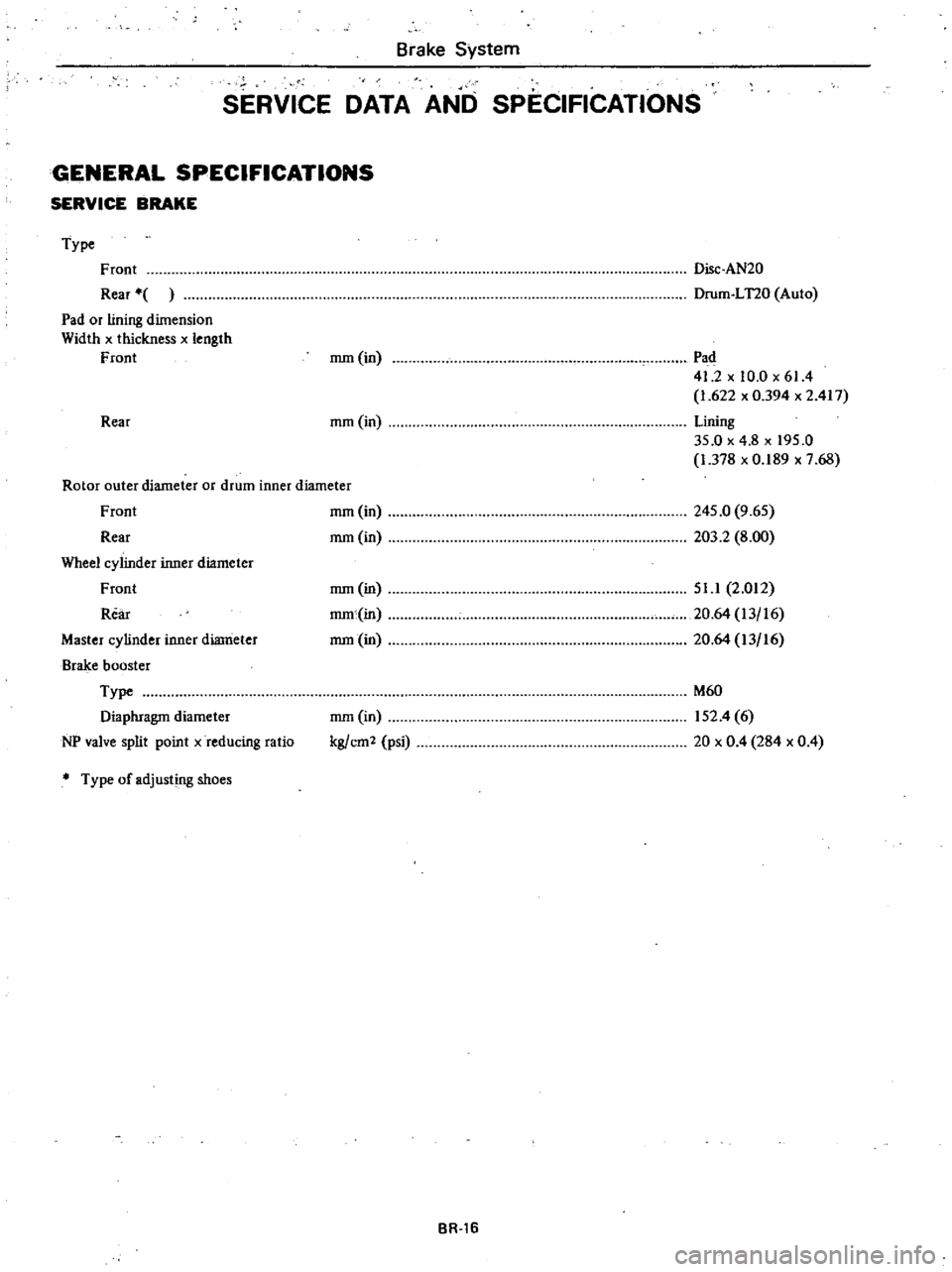
Brake
System
SERVICE
DATA
AND
SPECIFICATIONS
GENERAL
SPECIFICATIONS
SERVICE
BRAKE
Type
Front
Rear
Pad
or
lining
dimension
Width
x
thickness
x
length
Front
Rear
Disc
AN20
Drum
LT20
Auto
rnm
in
Pad
41
2
x
10
0
x
61
4
1
622
x
0394
x
2
417
Lining
35
0
x
4
8
x
195
0
1
378
x
0
189
x
7
68
mm
in
Rotor
outer
diameter
or
drum
inner
diameter
Front
Rear
Wheel
cylinder
inner
diameter
Front
Rear
Master
cylinder
inner
diameter
Brake
booster
Type
Diaphragm
diameter
NP
valve
split
point
x
reducing
ratio
Type
of
adjusting
shoes
rnm
in
rnm
in
245
0
9
65
203
2
8
00
rnm
in
mm
in
rnm
in
51
1
2
012
20
64
13
16
20
64
13
16
mm
in
kg
cm
2
psi
M60
152
4
6
20
x
0
4
284
x
0
4
BR
16